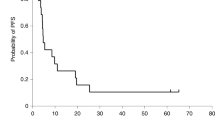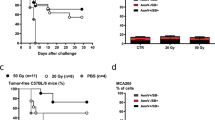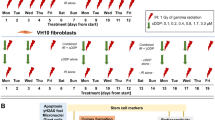Abstract
The viral ribonucleotide reductase (rR)-defective herpes simplex type-1 (HSV-1) virus (hrR3) has been shown previously to preferentially replicate in and kill tumor cells. This selectivity is associated with tumor cell up-regulation of mammalian rR. Ionizing radiation (IR) is currently used in the therapy of many malignancies, including glioblastoma, cervical carcinoma, and pancreatic carcinoma. IR has been shown to up-regulate mammalian rR in tumor cells and appears to increase the efficacy of at least one non-rR-deleted HSV-1 strain in an in vivo tumor model. Here, we test the hypothesis that a single therapeutic radiation fraction will increase the replication and toxicity of hrR3 for malignant cell lines in vitro. PANC-1 pancreatic carcinoma, U-87 glioblastoma, and CaSki cervical carcinoma cell lines were treated with varying doses of IR and subsequently infected with hrR3 or KOS (wild-type HSV-1 strain). Cell survival was then measured using the 3-(4,5-dimethylthiazol-2-yl)-2,5-diphenyl tetrazolium bromide assay and trypan blue exclusion cytometry. At 72 hours posttreatment, irradiation with 2 Gy reduced survival from 100% to 76% in noninfected cells, from 61% to 48% in KOS-infected cells, and from 39% to 27% in hrR3-infected PANC-1 cells. As such, analysis of variance indicated that the toxicity of the two modalities was additive. Similar additivity was seen in U-87 MG and CaSki cells. Absolute survival of hrR3-infected or KOS-infected PANC-1 cells decreased as a function of time after treatment (24–72 hours) and multiplicity of infection (MOI) (0.05–5.0). However, the relative decrease in survival with the addition of IR to hrR3 or KOS in PANC-1 cells was not markedly affected by altering MOI (0.05–5.0), time (24–72 hours), radiation dose (2–20 Gy), or cell culture conditions (confluent/growth arrested). We used fluorescence-activated cell sorter analysis with the cationic lipophilic dye DiOC6 to quantify a reduction in mitochondrial membrane potential that is associated with apoptosis. Fluorescence-activated cell sorter analysis indicated increased apoptosis in both hrR3- and IR-treated cells at 48–72 hours, with hrR3 alone producing the most induction. Viral yields from PANC-1 cells after irradiation and infection were examined. No significant differences were seen between irradiated and nonirradiated cells in viral replication, with hrR3 producing single-step titers of 3.1 ± 0.9 × 105 and 4.0 ± 1.2 × 105 plaque-forming units/mL in nonirradiated and irradiated cells. Thus, complementary toxicity was seen between IR and hrR3 or KOS, regardless of cell type, time, MOI, IR dose, or culture conditions, without evidence of augmented apoptosis or viral replication.
This is a preview of subscription content, access via your institution
Access options
Subscribe to this journal
Receive 12 print issues and online access
$259.00 per year
only $21.58 per issue
Buy this article
- Purchase on Springer Link
- Instant access to full article PDF
Prices may be subject to local taxes which are calculated during checkout
Similar content being viewed by others
Author information
Authors and Affiliations
Additional information
This paper was presented at the 90th Annual Meeting of the American Association for Cancer Research, Philadelphia, PA, April 10–14, 1999.
Rights and permissions
About this article
Cite this article
Spear, M., Sun, F., Eling, D. et al. Cytotoxicity, apoptosis, and viral replication in tumor cells treated with oncolytic ribonucleotide reductase-defective herpes simplex type 1 virus (hrR3) combined with ionizing radiation. Cancer Gene Ther 7, 1051–1059 (2000). https://doi.org/10.1038/sj.cgt.7700208
Received:
Accepted:
Published:
Issue Date:
DOI: https://doi.org/10.1038/sj.cgt.7700208
Keywords
This article is cited by
-
Antitumor effects of IL-12 and GM-CSF co-expressed in an engineered oncolytic HSV-1
Gene Therapy (2021)
-
The combined effects of irradiation and herpes simplex virus type 1 infection on an immortal gingival cell line
Virology Journal (2014)
-
MicroRNA-145 regulates oncolytic herpes simplex virus-1 for selective killing of human non-small cell lung cancer cells
Virology Journal (2013)
-
The integrin inhibitor cilengitide enhances the anti-glioma efficacy of vasculostatin-expressing oncolytic virus
Cancer Gene Therapy (2013)
-
Impact of novel oncolytic virus HF10 on cellular components of the tumor microenviroment in patients with recurrent breast cancer
Cancer Gene Therapy (2012)



